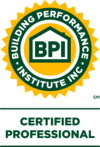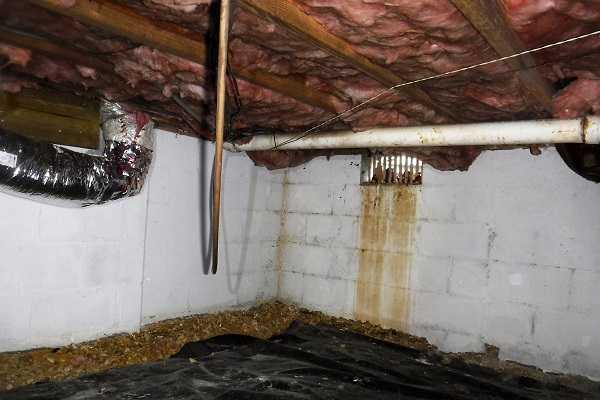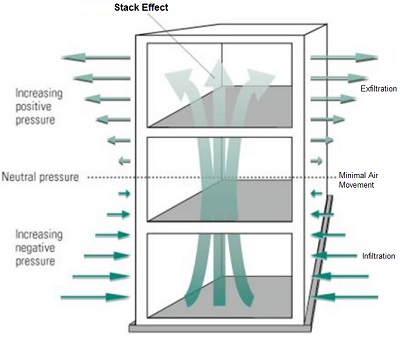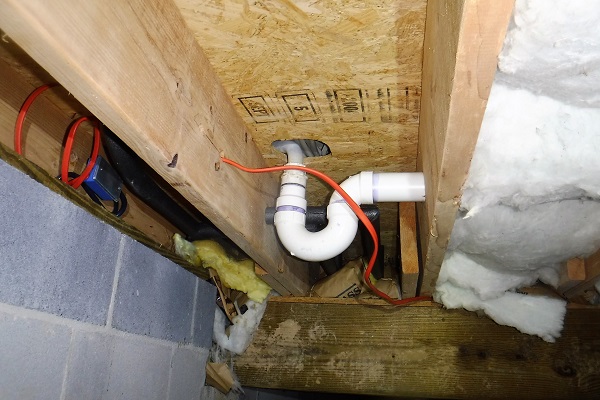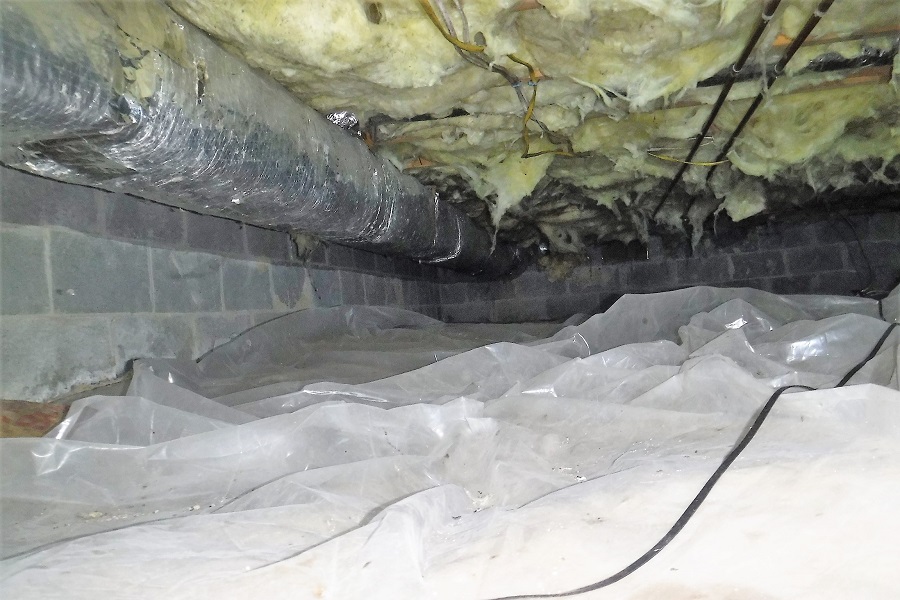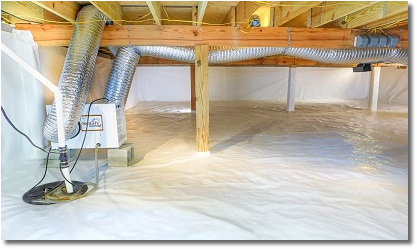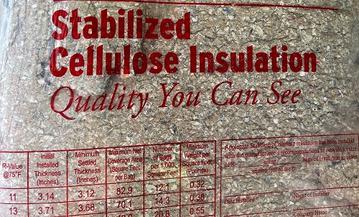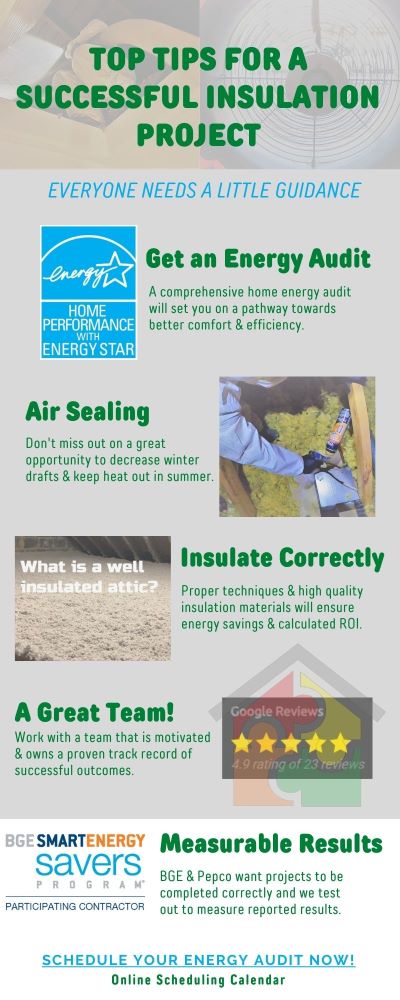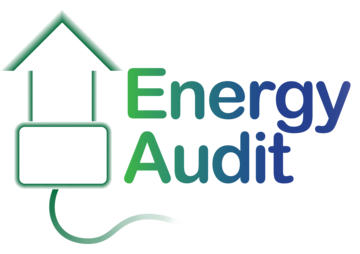Residential Comfort & Energy EfficiencyMonday, August 14 2023
Let's face the facts about crawl spaces. They leave a lot to be desired. Most crawl spaces are difficult to access in most cases they are stuffy, dusty, and full of insects. To make matters more complicated there are so many questions about how to properly seal and insulate an open crawl space. For example: When should crawl space vents be open? As an energy auditor, certified through the local Maryland utility, it is important to properly examine a crawl space in a number of different scenarios which can be complicated. My method of simplifying the way I think helps me figure out the right solutions and explain them in easy-to-understand ways to the homeowner. The information below is common insights required to make an informed decision about how to properly treat your crawl space.
Old School Thinking: I See Insulation Everything is FineIf you live in a home on a crawl space there is a very good chance that you think that this just is the way it is and there is not much you can do. When you first moved in you ambitiously went into the crawl and you saw insulation below the floor. Everything seemed fine. Maybe you have never looked in the direction of your crawl space, or any crawl space for that matter, and have no idea what one may look like. If that is the case, have a look at this video taken during a BGE energy audit of a typical open crawl space.
When Should Crawl Space Vents Be Open? | ||||||||||||||||||||||||||
BOUNDARY LOCATION REQUIRED R-VALUE MARYLAND |
|
|---|---|
| Attic Flat | |
| Ending R-value of 49 or as space allows | |
| Attic Slope | |
| Ending R-value of 38 or as space allows | |
| Vertical Wall (basement, crawl space, knee wall) |
|
| Ending R-value of 11 or greater | |
| Crawl Space Ceiling | |
| Ending R-value of 25 or as space allows | |
| Below Cantilever | |
| Ending R-value of 25 or as space allows | |
| Rim Joist (top of foundation wall in basement) |
|
| Ending R-value of 19 or greater |
Determine what Type of Insulation You Have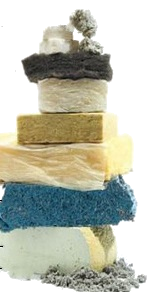
Different attic insulation materials and levels yield wide-ranging R-values.
So, it is first important to determine the type of insulation that is in your attic.
Typical Insulation Materials Found in Maryland Attics
- Fiberglass batts
- Loose-fill fiberglass
- Loose-fill cellulose
- Mineral wool
- Two-part spray foam
Identifying the Most Common Maryland Insulation Types
Cellulose Loose Fill
General Characteristics
- Grey in color
- More dusty and clingy than other materials
- Has bits of newspaper in it
- Good fire/mold retarder w/ additives
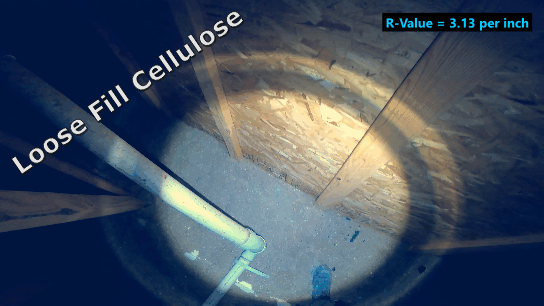
Rolled Fiberglass Batt Insulation
General Characteristics
- Typically referred to as batt insulation
- Has the kraft paper or aluminum foil on one side
- Recognizable due to the "Pink Panther" commercials
- Must be installed flawlessly (unforgiving)
- Low R-value per inch if not installed properly
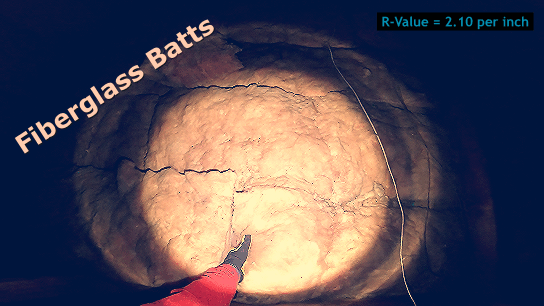
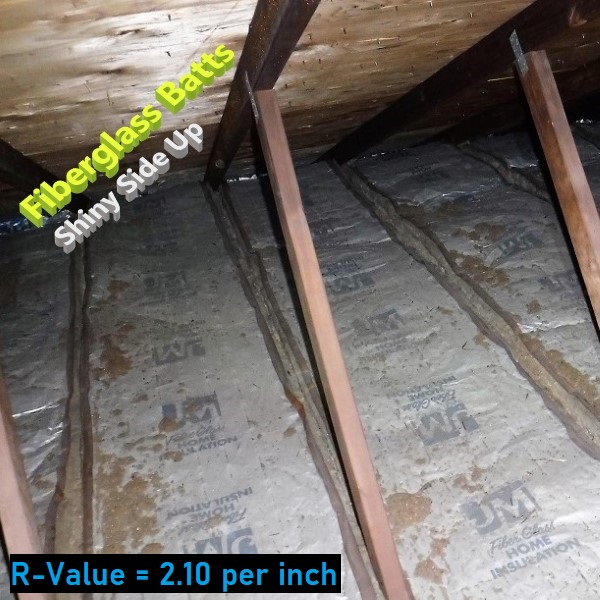
Fiberglass Loose Fill
General Characteristics
- Typically white shreds, pink squares or yellow shreds
- Much less dusty
- Lower cold weather performance than cellulose
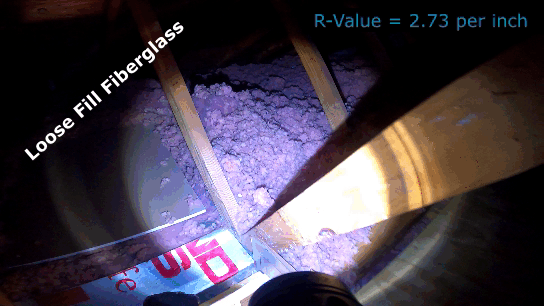
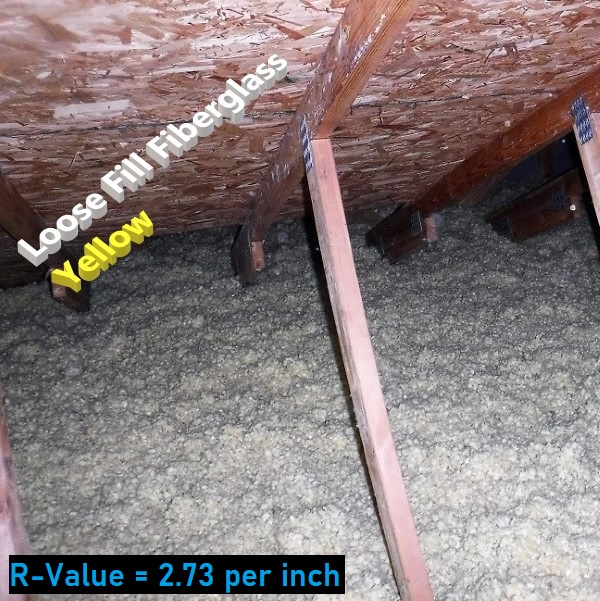
Determine Your Attic Insulation's Condition
The condition of the existing insulation in an attic is also important. Obtaining the information will assist in generating a reliable return on investment reporting. Current conditions can also reveal clues about future comfort gains.
R-value can be misleading if several factors are not met:
- Installation integrity
- Missing pressure boundary (air sealing around gaps/voids)
- Overall insulation coverage (distribution)
Your insulation should get a rating of "poor", "moderate" or "well" insulated.
Attic Insulation in Poor Condition
Insulation with large gaps and voids. Missing insulation greater than 2% of the insulated area.

Attic Insulation in Moderate Condition
Insulation with defects and gaps around wiring, electrical outlets, plumbing, and other intrusions. Rounded edges or "shouldered". The amount of fill is incomplete, but rarely dips less than 30% of the intended thickness. Gaps and spaces running clear through the insulation should be no more than 2% of the insulated area.

Well Insulated Attic Characteristics
The insulation has no large gaps or voids around obstructions. The insulation appears to fit in any cavity side-to-side and top-to-bottom. The insulation appears to be around wiring and other services in the area.

Different Insulation Types & Conditions = Different R-Values
The values for the corresponding condition of your attic insulation can be multiplied by the number of inches you have to see where your attic falls on the scale.
- Loose Fill Cellulose
New: 3.60 R-value per inch
Existing Well: 3.60
Existing Moderate: 3.13 R-value per inch
(Example: 6" = R19; 10" = R31)
Existing Poor: 2.7 R-value per inch
- Fiberglass Batt Insulation
New: 3.14 R-value per inch
Existing Well: 2.67
Existing Moderate: 2.10 R-value per inch
(Example: 6" = R13; 10" = R21)
Existing Poor: 1.26 R-value per Inch
- Loose Fill Fiberglass
New: 3.14 R-value per inch
Existing Well: 3.14
Existing Moderate: 2.73 R-value Per inch
(Example: 6" = R16; 10" = R27)
Existing Poor: 2.36
How Much Does Insulation Cost in Maryland?
Watch a uniformly blown cellulose attic insulation job in progress!
Maryland Insulation Rebates
How the Insulation Program Works
Maryland Utilities (BGE & Pepco) offer a portfolio of programs promoting energy efficiency and conservation, including rebates, education, and services. The program is designed around a consultative approach.
Air sealing and insulation are considered the most important measures to complete to achieve energy efficiency - before windows, doors, and replacing older HVAC.
The initial qualifier for rebates is to get a home energy audit.
LEARN MORE
Maryland Residents Learn More About the Inflation Reduction Act Here
Take the Next Step
Don't hesitate. Schedule online. Only $100 in the end.
Get a home energy audit & get questions answered such as:
Why is the room on the front of the house colder?
Do you have enough insulation?
Why is it so stuffy upstairs during the summer?
Should I remove old insulation from my attic?
Why does my HVAC run all of the time?
Is spray foam insulation the best solution for my home?
Why are my new windows feeling drafty?
Do my walls have insulation?
Wanna know more about the home energy audit process?

Energy Audit Guides
-2023 BGE Energy Audit-
-2023 Pepco Energy Audit-
Do you need an energy audit?
Check your house for any of these 5 signs...
A home energy audit is the GPS of home improvements...

Turn-by-turn directions to better comfort & energy efficiency.
Schedule yours today!
Un-insulated Areas Play a Heavy Hand in Poor R-Values
Now let's go a little deeper and explore the impact of un-insulated surfaces. It may surprise you how important having an even blanket of insulation is for getting a great result.
If you notice any area in your attic that does not have insulation then pay attention to the information below!
This typical Maryland attic is a great example of what the impact of missing insulation can have.
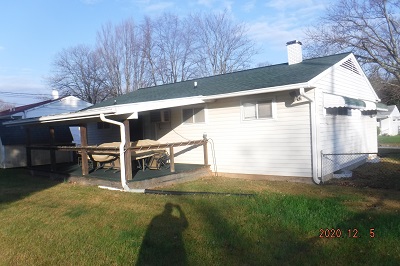
The attic area in the home pictured above is 975 square feet and flat (R-49 recommended in Maryland).
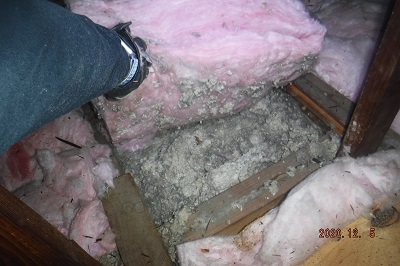
You will notice 1" of blown-in fiberglass insulation and 7" of rolled fiberglass batting laid on top.
In this scenario, the attic has roughly 8" of insulation in "most" of the areas that need it. Later you will learn how to use the depth to determine the R-value. In this case, the attic is R-17...
But, there is a catch!
There are two major un-insulated areas in this attic (very common in Maryland attics).
1. A three-foot by three-foot push up hatch
2. A three-foot by three-foot whole house fan
Equaling a total of 18 square feet of un-insulated area on the attic floor.
This equates to just about 2% of the attic area (18 divided by 975).
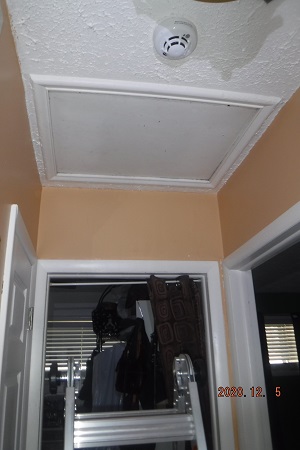
Typical hallway push-up hatch leading to an under-insulated Maryland attic. Watch how a hatch gets treatment.
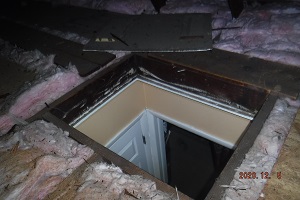
The hatch from the attic has a plywood cover (seen in the background)
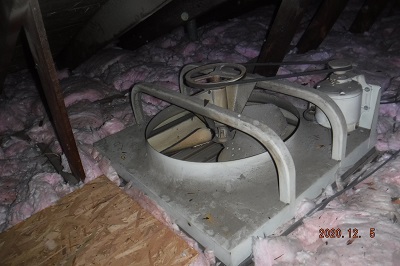
Whole house fan is seen from the attic.
With the use of the HOME ENERGY SCORE CALCULATOR, we are able to calculate the impact un-insulated surfaces have on insulation performance.
The picture gets clear!
What ends up happening with this common scenario is not good. A mere 18 square feet of missing insulation has a big impact. The expected R-value reduces down from 17 to 13 for the entire attic!
That translates to hot summer nights and cold winter drafts and high energy bills to pay.
REASON:
According to Dr. Allison Bailes of Energy Vanguard, the heat flows through the bare areas fast. Based on his article, the air leaves in the un-insulated ceiling area are as much as 38 times faster than in the insulated areas.
Conclusion
Be sure to measure your attic insulation in a precise fashion. Different areas that have different levels should be separate. Each area will get an R-value assessment. Along with knowing the condition, this weighted average calculator can then help you determine your attic's R-value.

Written by Eric Gans
I am a student of Building Science. I'd like to help you assess how well the different parts of your home are working to see how likely you are to beat the Maryland summer heat.
Maryland homeowners turn to their HVAC contractors when the temperature inside heats up.
But, after HVAC people install the machine and controls, it stops there. They have very little to do with the comfort level in your home.
It's a good practice to focus on the shell around your home. A well-sealed and insulated shell can play a big part in properly controlling the climate inside your living space on a hot summer day.
You need to know:
- What is the shell?
- Where is the shell?
- And, what condition is it in?
The good news is that often, the shell is easy to fix.
What is the Shell of Your Home?
It is where the inside touches the outside on the six sides of your building.
The location of your home's shell can vary. When you determine its location, you have to look for two things.
First, a pressure boundary or tight seal to stop airflow. Second, and more familiar to most, is the thermal boundary. The correct amount of insulation must exist to slow the transfer of heat.
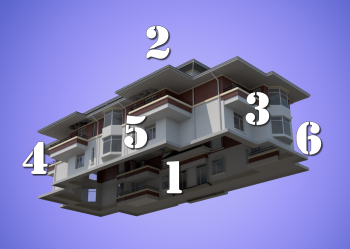
The shell of a home is on six sides. Wherever your home touches the outside, you must protect it with a proper shell.
Never assume the location of your home's shell without a little investigative work. You can have two homes that are exactly the same and each might have a different shell configuration.
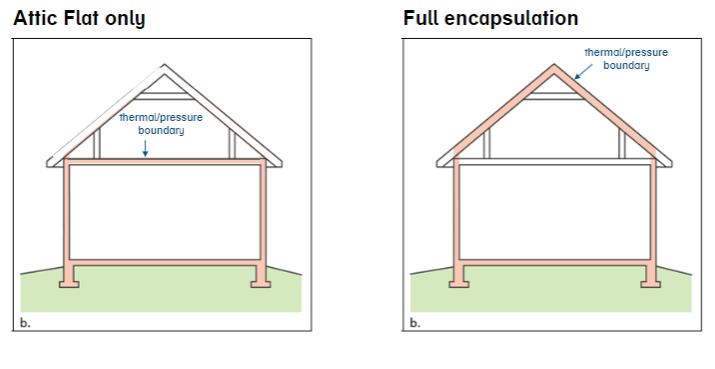
The big secret in Building Science is to address the shell where it is most important and easiest to access. This includes attics, crawl spaces, basements, and unfinished walls.
Don't be afraid to get an energy audit if you want someone to check it for you. An energy audit is a great way to have a professional assess your home's shell.
In this article, we'll explore the following topics:
- Root causes of a hot upper floor
- The negative effects of a warm home
- Misconceptions about hot upper floors
- What you will need to WIN! summer
- Specific examples of common issues
- Practical solutions and strategies
The goal is to help you beat the Maryland summer heat and transform your home into a refreshing oasis.
Why are the Upper Floors So Hot?

As the weather heats up, I visit Maryland homes to perform energy assessments and the scenes are usually the same.
The houses I inspect have large openings to the outside. Sealant and insulation are missing. Sometimes it is in bad condition and installed wrong. The problems are quite common in Maryland homes, new and old.
Older Maryland homes have older construction concepts. As a result, large gaps and voids have gone unchecked for decades. New builds are often times insulated wrong because nobody knew any better.
Check out this long YouTube video where an energy audit was performed at a new build (2018) and you can see first-hand.
A large unsealed pathway around the furnace chimney in a 1970s attic. Like an open window 24/7-365.
The fact is, attics and crawl spaces do not get the love they need. As a result, they will not be up to the challenge that awaits them. A hot Maryland summer can overcome the often weak defensive systems I see.
Although the area of an attic is not traveled, it is a harsh environment. It needs upkeep and improvements. Building codes and techniques for insulating have changed. Especially in the last ten years.
But, don't sweat! It does not have to remain this way. There are many solutions available to Maryland homeowners. You can address these issues and cool down the upper floor of your home!
Anyone in Maryland can get an energy audit for $100. It is through the BGE and Pepco Home Performance with ENERGY STAR® program.
Negative Effects of a Warm Home in Summer
A hot upstairs can be a real drag. When the upper floor is hot and uncomfortable, it can make it difficult to relax, sleep or even work. The constant discomfort and lack of proper rest can lead to increased irritability. It can affect one's stress level and quality of life.
Besides, a hot home can make it harder to enjoy indoor activities. Cooking, watching TV, or spending time with family and friends is too much.
Hot upper floors increase energy costs. Homeowners need to rely on air conditioning more to achieve a comfortable temperature.
If that is not bad enough, a hot upper floor can also affect the resale value of the home. If a buyer perceives the upper floor to be uncomfortable it can reduce the value of the property.
Misconceptions: Accepting Hot Upper Floors & Attic Fans
A common misunderstanding is that this is the way it is and there is nothing that can fix the problem.
So many Maryland homeowners accept this way of life. Some adapt to it by moving their bedrooms around the house during the different seasons. It is the only way they can maintain comfort and get the rest at night that they need to function.
Many I meet rely on decreasing the heat in the attic by adding ventilation. They are hopeful it will help with the situation inside the house. Unfortunately, it doesn't work. The attic will still get too hot and with weak defenses, heat will seep in.
You also have to be careful with attic fans installed on the roof or in a gable. You don't want to contribute to your problem. If the house is not sealed from the attic the pressure will draw your cool through existing holes.
Watch a demo of this in the video below.
A hot upper floor can have a negative impact on a homeowner's mental and emotional well-being. It can also reach into your finances and home value. Taking steps to address the root causes of the problem can enhance your quality of life. You can finally have a strategy to win!
What You Need Around the House to WIN! Summer
A hot upper floor in a Maryland home is a common recurring problem. It is due to our hot and humid summers combined with inadequate insulation defenses.
When working to keep your home cool in the summer, you have to check the different parts of the TEAM against summer.
Here are five members that are a big part of the winning strategy and each has to be at the top of their GAME!
-
Insulation - The most important is the attic. If not insulated, heat gains a direct path to your living space. It radiates into the attic and through the ceiling. This can result in a hot and uncomfortable upper floor. Energy bills are higher due to the increased use of air conditioning
-
Air sealing - There are gaps and cracks around your house. Examples include light fixtures, walls, vents, and ducts. If not sealed, they allow hot air to enter the upper floor, while cool air escapes. This can disrupt the temperature balance and make it harder to cool down the upper floor
-
HVAC duct leakage - If not sealed, it may struggle to cool down the upper floor.
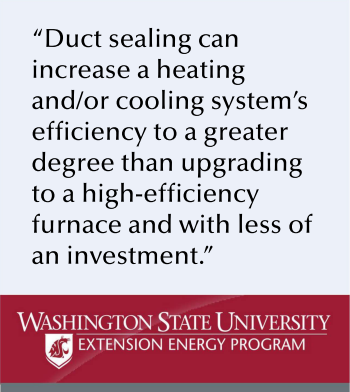
-
Ventilation issues - A lack of airflow can make an upper floor feel stuffy and uncomfortable.
- Solar heat gains through windows - Maryland summers are sunny and hot. As a result, radiant heat will beam through windows. Allowing it will make it difficult to regulate the temperature inside.
Examples of the Problems that Lead to Hot Upper Floors
Insulation Problems
Many of the homes I visit that suffer the most in summer have missing insulation. Many also have raised, sloped ceilings which create vertical walls in the attic. Jammed insulation into a vertical space in a harsh environment is not good. Usually, with nothing holding it in place, it is less than effective.
It falls or sags, leaving large gaps in coverage that cause rapid heating on upper floors.
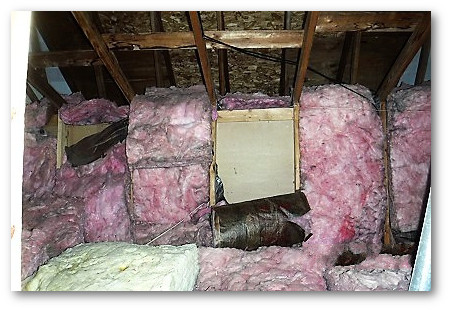
Missing insulation on a knee wall in a Maryland attic.
Shell Air Leakage
Excessive air leakage between the inside and the outside creates an uncomfortable home. A big problem in the summer is humidity. Sealing the house and reducing outside air infiltration helps to keep it dry inside. Dry inside air helps to maintain a more comfortable home on each floor.
HVAC Duct Leakage
If you have any HVAC ducts running through your attic or crawl space it is a good idea to get them assessed. According to ENERGY STAR data, as much as 20-30% of the air that moves through your duct system will get lost due to leaks. A duct assessment takes place during an energy audit.

In typical homes, 30 to 40 percent of the air that moves through ducts is lost due to leakage.
Importance of Proper Ventilation
Most exhaust fans in Maryland bathrooms turn on and make a lot of noise, but rarely do they work. Older models are awful at pulling out moisture after a shower. Fans that are working usually blow moisture into the attic. This contributes to the moisture content and makes it more difficult for the HVAC to keep up.
Close Window Shades & Blinds
Solar gains through clear windows contribute to uncomfortable indoor temperatures. You don't need new windows with a special glass package to solve the problem.
Shades or a film should cover windows in the locations that get the most sun. Southern and western-facing windows are the most important.
Modern Air Sealing and Insulation Techniques
The best defense against heat is an insulation strategy. Oftentimes, insulation exists in some form. Inspectors and homeowners check the box, and sight unseen. Insulation is not the thing people dream about when it comes to home improvements.
Insulation’s job is to slow the transfer of heat. When the heat in the attic builds, weak insulation will fail. Guess where the heat will go? Yep, into your living space making things uncomfortable.
Before any attic gets more insulation, it must be air sealed. Air sealing the gaps, cracks, and crevices around the attic will ensure two things. First, the insulation can work to specification. Sealing will also keep the warm, humid air from being able to enter the upper floors.
Air Sealing Examples
Air sealing and insulating ducts around your home should be a priority. Sealing ducts that are outside is a fantastic opportunity. Doing so will help to send more cool air to the places you want it to go.
Often overlooked, the common bathroom exhaust fan has a huge role to play. Moisture lingers after showering if you allow it to do so. This will increase humidity and make it harder to cool the upper floor.
New high-performance bathroom exhaust fans are a game-changer. New fans move a large volume of air super fast. They are also quiet. Keeping the air dry inside your home during summer is a key to success.
Additional DIY Solutions
If you don't have a big budget at the moment, don't worry.
There are several other things you can do around your home to begin to get your upstairs back.
-
Keep blinds and curtains closed during the day, particularly in the rooms that get the most sun.
-
Air seal larger, easy-to-reach gaps and cracks around your basement and attic. Be sure to use foam sealant.
-
Use ceiling fans in the rooms you are occupying, turn them off in rooms, not in use.
-
Upgrade to a smart thermostat that can track your habits. It can help track movement around the house to improve comfort and efficiency.
-
Keep an annual HVAC maintenance schedule for a check-up to keep things working well.
-
Locate the seams, gaps, and cracks in your HVAC ducts. Check closest to the air handler and seal them with high-quality duct sealant.
-
Insulate and seal the attic hatch or pull-down stair leading to the attic.
-
Look at your filter slot cover at your inside air handler and check that it has a cover and seal.
Filter Slot Cover Example Video
Hot upper floors can be a frustrating and uncomfortable problem. Maryland homeowners should know that better comfort is not insurmountable.
Drilling down to the root causes of the problem will help you enjoy a cool and comfortable living space. Poor insulation, air leaks, and an inefficient HVAC system are all priorities. Assessing these areas will give you the answers you need.
A great way to beat the Maryland heat is to get a comprehensive home energy audit.
A professional auditor can help you identify energy-saving opportunities. With energy savings comes comfort as well.
So don't wait - take action today and start your journey towards a cool and energy-efficient home.
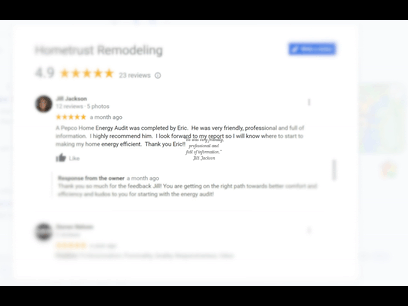
A shameless plug! Get an energy audit today!
AI helped me with this blog post by taking my desire to produce an article that will help my fellow Marylanders create a cooler home for the summer and organize a framework with some context to convey my general message which is, with a little knowledge and investigative work, you can take a systematic approach to solving comfort issues and create a more efficient home.
Montgomery County - Maryland
You might say that a Colonial is the most common home you will see. Usually two stories, A-framed and rectangular, they are also fairly simple - on the outside.
Inside, they are complex structures with lots of different ways your conditioned air finds ways to escape.
Colonial style houses typically have good accessibility to the key places that need to be sealed and insulated so they are usually good candidates for measurable results.
The most important areas to insulate in Colonial style homes include the attic and foundation.
First Step - Energy Audit Assessment
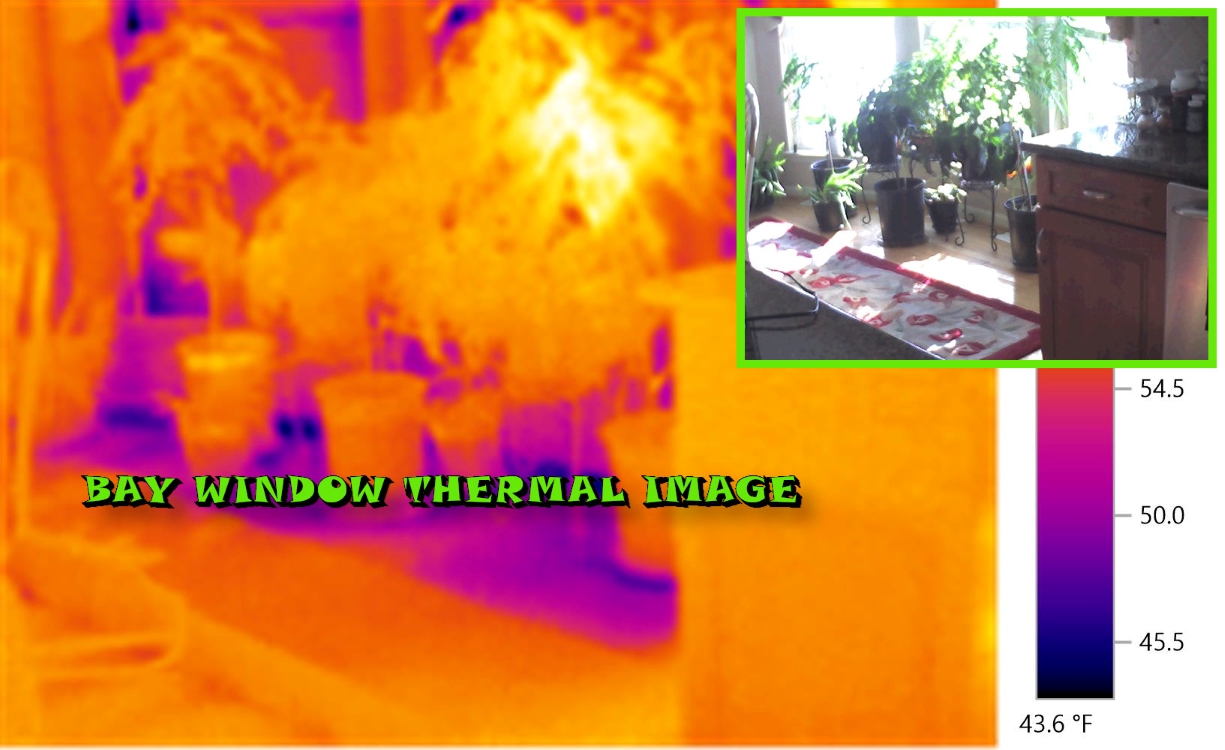
Getting a comprehensive home energy audit is the best way to find what places are most important to insulate around a Colonial style home.
Sometimes homeowners think an energy audit is a critique of their energy habits, but it is not. Instead, you get a certified and trained pro that shows up ready to help you discover ways to tighten up your home. And, where to look is not always as obvious as it may seem.
As an example, a well performed energy audit can sort through the HVAC system to determine ways to improve efficiency.
Opportunities to do so might include:
- Sealing large HVAC duct openings in the attic
- Sealing the ducts themselves
- Insulating ducts
- Encapsulation
- Improved duct placement for better flow
Many of the biggest issues causing comfort problems are hiding in plain sight and an energy audit can illuminate them right before your eyes!
An energy audit will assess your insulation right on the spot and give you sound advice about how to improve the boundary between the inside of your home and the outside - which is the name of the game!
The Scenario: Classic Colonial with Addition
In this example, the homeowner was mainly concerned about a very cold house in the winter.
The rear addition was added around 2001. It opened up the kitchen and dining room quite nicely.
Insulation complexities can arise when new spaces are added to the existing structure.
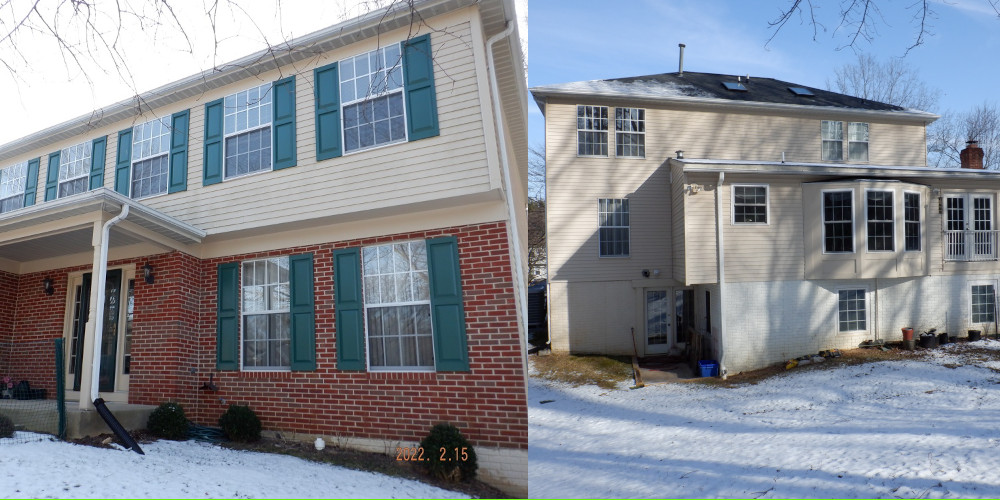
The homeowner pointed out that the floors and cabinets were cold.
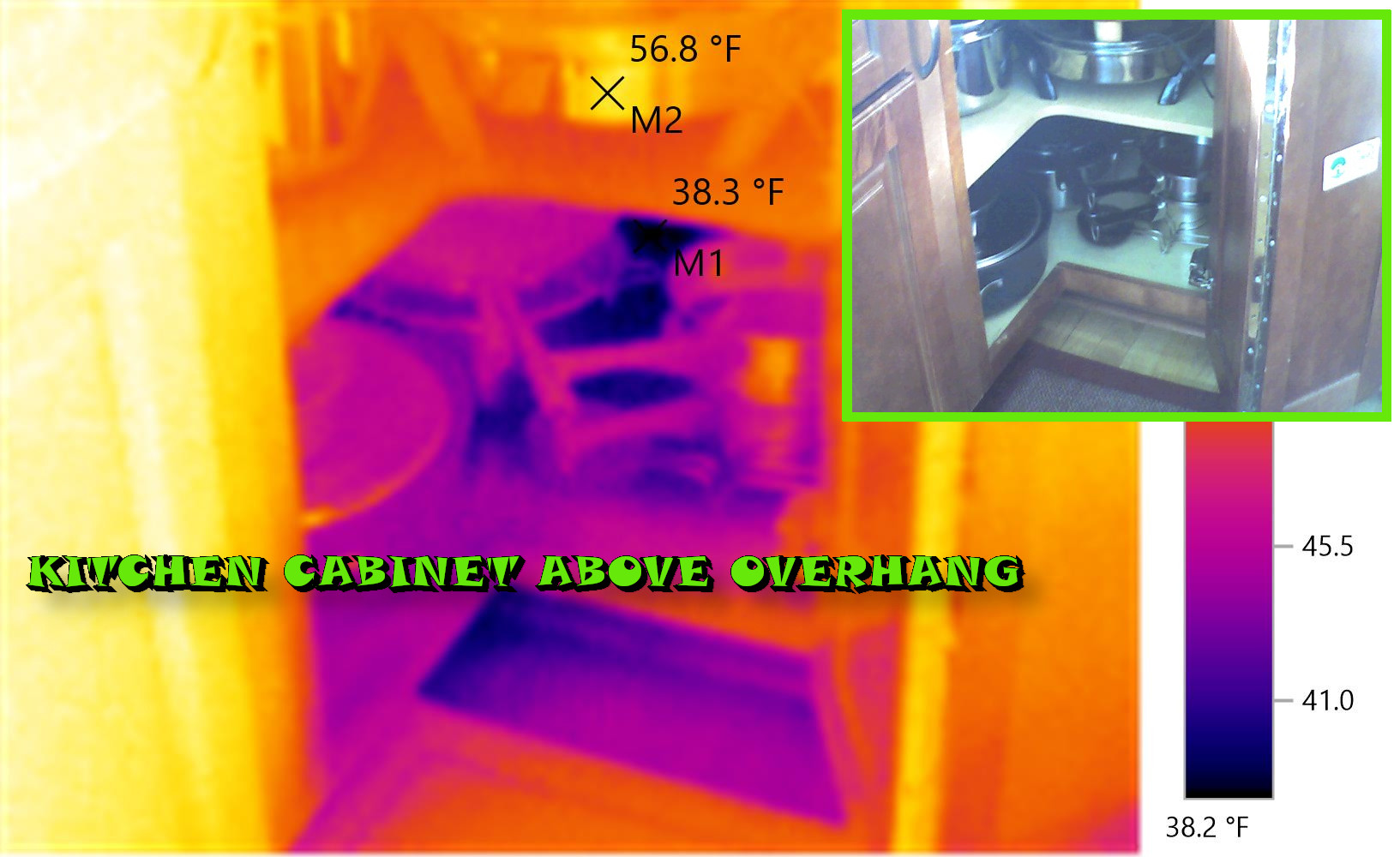
According to them, it was a let down. A lot of thought had gone into the design of the new space. Comfort was high on the list, but the plan missed the mark when it came to temperature control and they were seeking the cause and a fix.
How to Make Insulation Decisions for a Colonial Style Home
Understanding Stack Effect & How it Can Wreak Havoc with Comfort
Everyone should learn about the stack effect when ready to purchase a home. 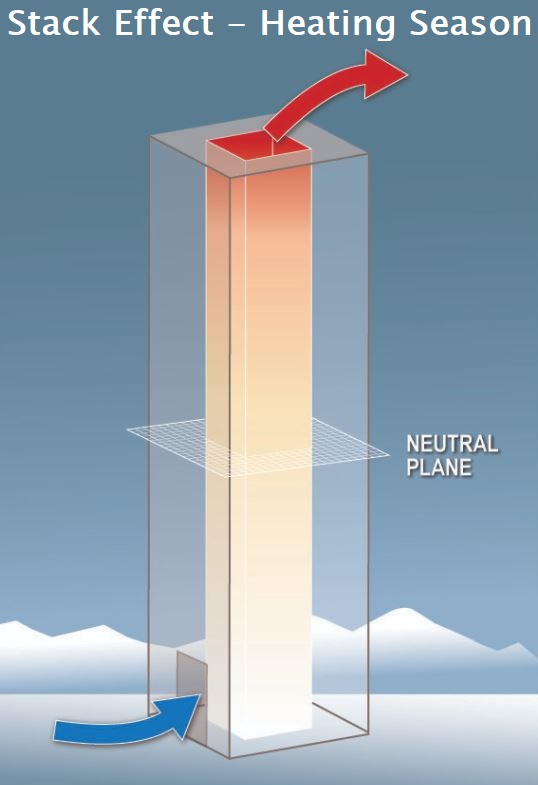
Knowing where and how the air leaves and enters your home can play a big part in attaining better comfort.
The stack effect can be simply understood by taking one concept we all learn as young children: Hot Air Rises
Here is the SECRET: when warm air goes up in your house it creates a lot of pressure at the top and all that warmth escapes through all of the holes in your ceiling right up into the attic if modern insulation techniques are not in place.
Many of the places where this is happening you cannot see, but they do exist!
If left unchecked, warm air escapes and then physics kicks in!
+ Positive Pressure at the Top
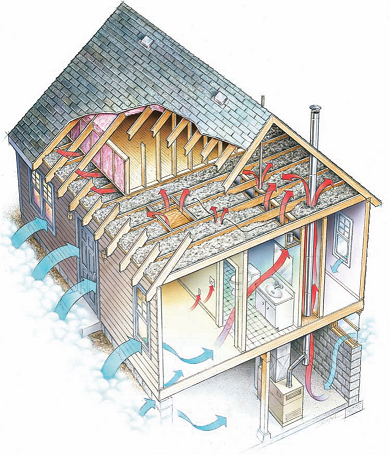
- Negative Pressure Down Low
For every bit of warm air that leaves (positive pressure) it gets replaced (negative pressure) by cold air from the outside.
If you apply this basic concept to the different areas around your home, you may see signs that the problem is happening to you too.
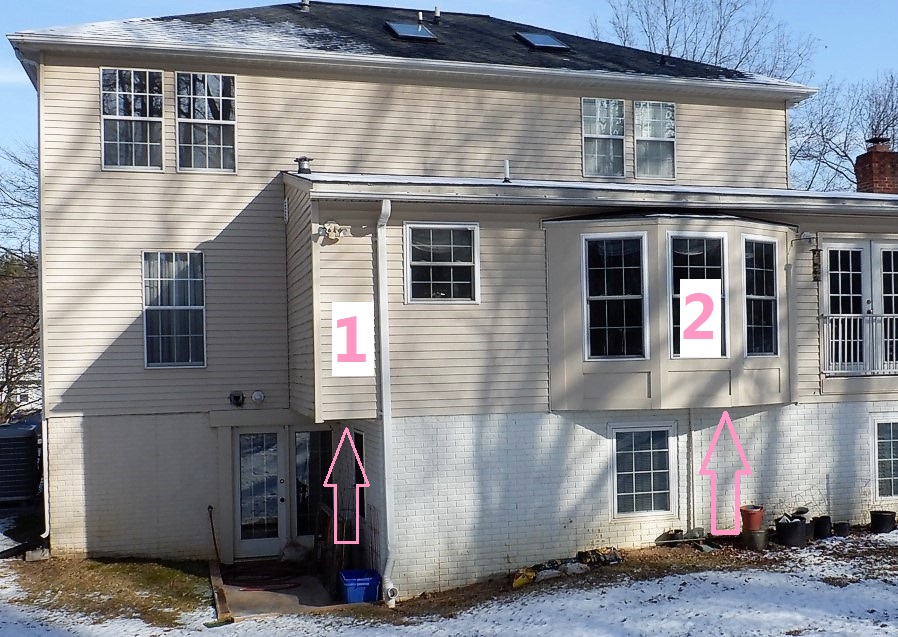
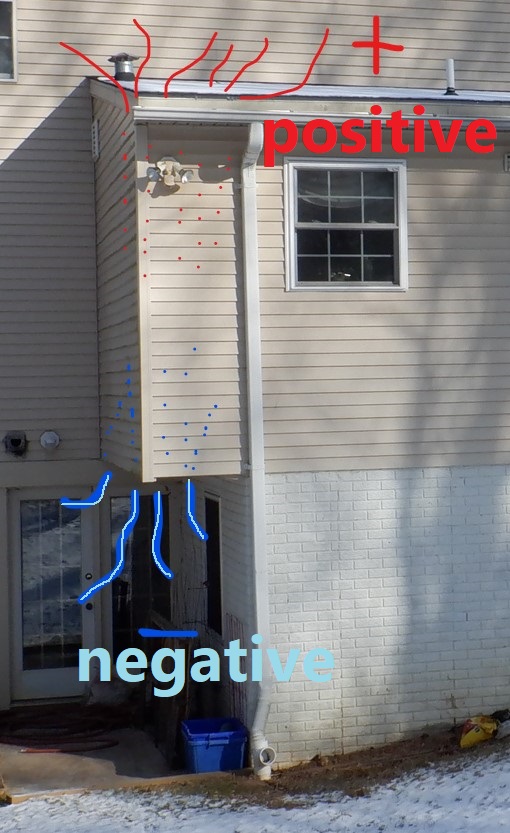
In the diagrams above it gets a little clearer as to why this family was having an issue.
The rear addition included two cantilevers to add to the overall square footage. These features are sometimes susceptible to air leakage if not insulated right and can cause hot and cold spots around a home.
Watch how leaky this cantilever is during a whole house air leakage test (blower door test).
How we Seal and Insulate Cantilevers
Humid Basements - Tipping You Off to High Air Leakage
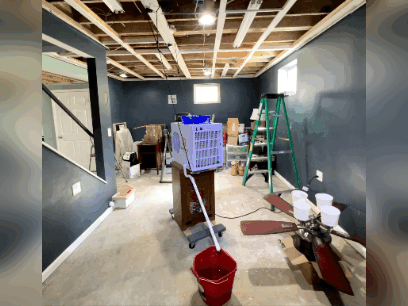
Basements can be major sources of energy loss by introducing warm humid air into the house in summer and cold dry air in the winter.
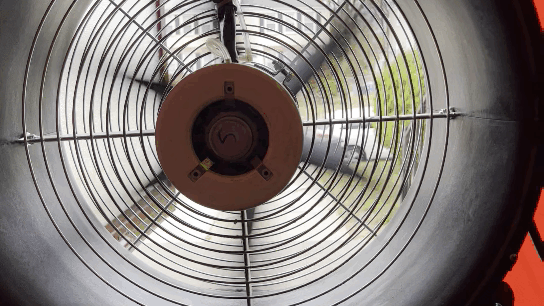
Sealing the air leakage around the top of the foundation wall in a Colonial style home is beneficial.
Sealing the Top (Attic) of a Colonial
With this powerful information about air movement, the first thing to do is look for ways to seal gaps at the TOP of your home.
Major sources of air leakage at the top of a typical Colonial style house include:
- HVAC Chase
- Chimneys
- Recessed Lights
- Tops of 2nd Floor Walls
- Attic Access Points
- Electrical Wiring Holes
An chase is a pathway behind walls that HVAC takes to get where it needs to go. These conduits are built into the home and should be somewhat inconspicuous. They house plumbing, ducts and chimneys. They are often responsible for a big temperature variance between floors.
Air is omni-present within the six sides of our buildings. Therefore, any open hole/gap at the attic floor (top floor ceiling) is a connection to the inside of your home.
Add pressure (stack effect) and air can escape really fast.
Don't be fooled anymore into thinking it is the windows that are causing your drafts and high energy bills.
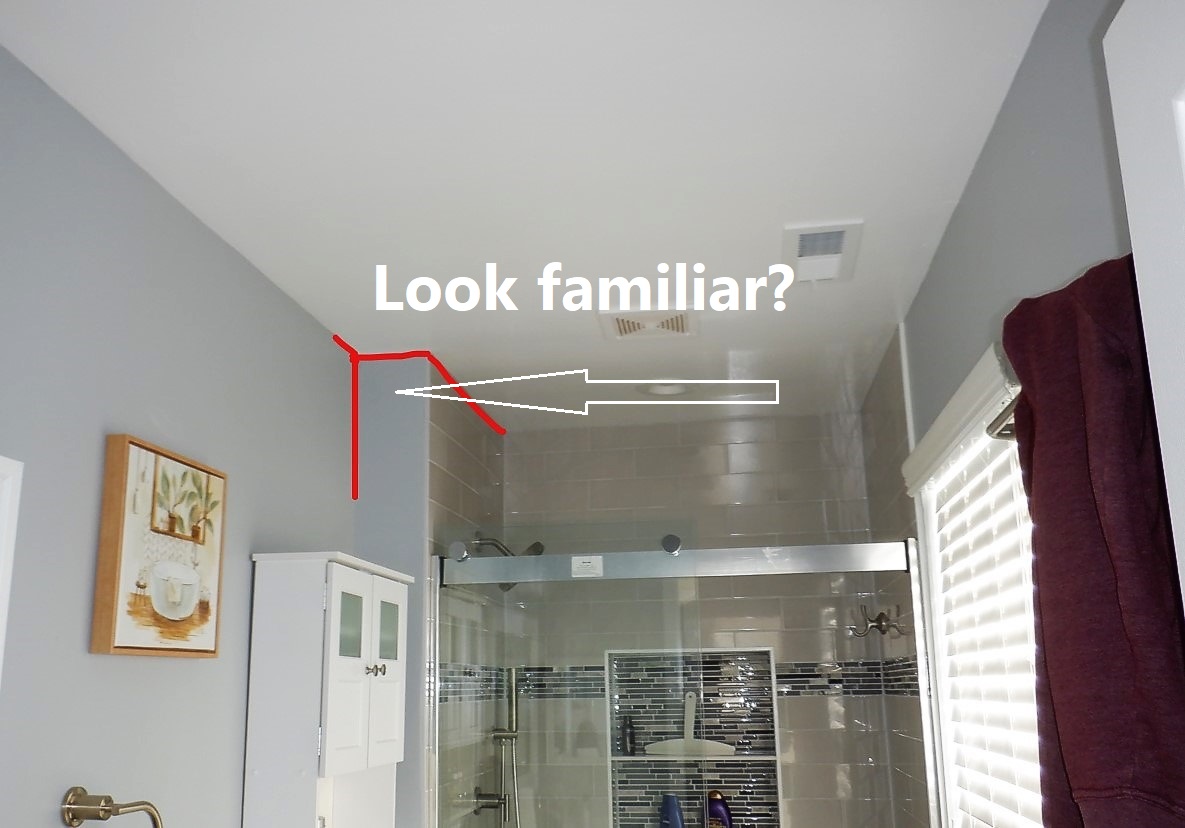
Example of an Open Plumbing Chase (Bathroom Side)
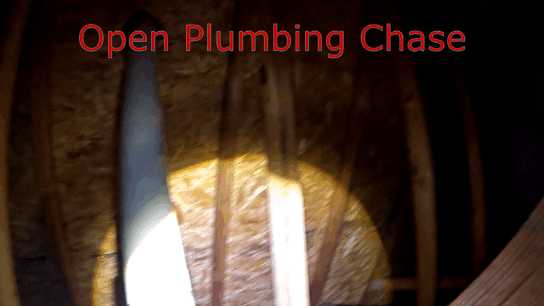
Example of an Open Plumbing Chase (Attic Side)
The Importance of Properly Installed Insulation
There is a false sense of security many homeowners have about their insulation.
Many make the mistake of relying on seeing insulation in the normal places as a firm signal that their house is well-insulated.
Most often it is quite the opposite. Usually, insulation levels are severely insufficient and a lack of air sealing makes existing insulation R-values less than what is listed on the package.
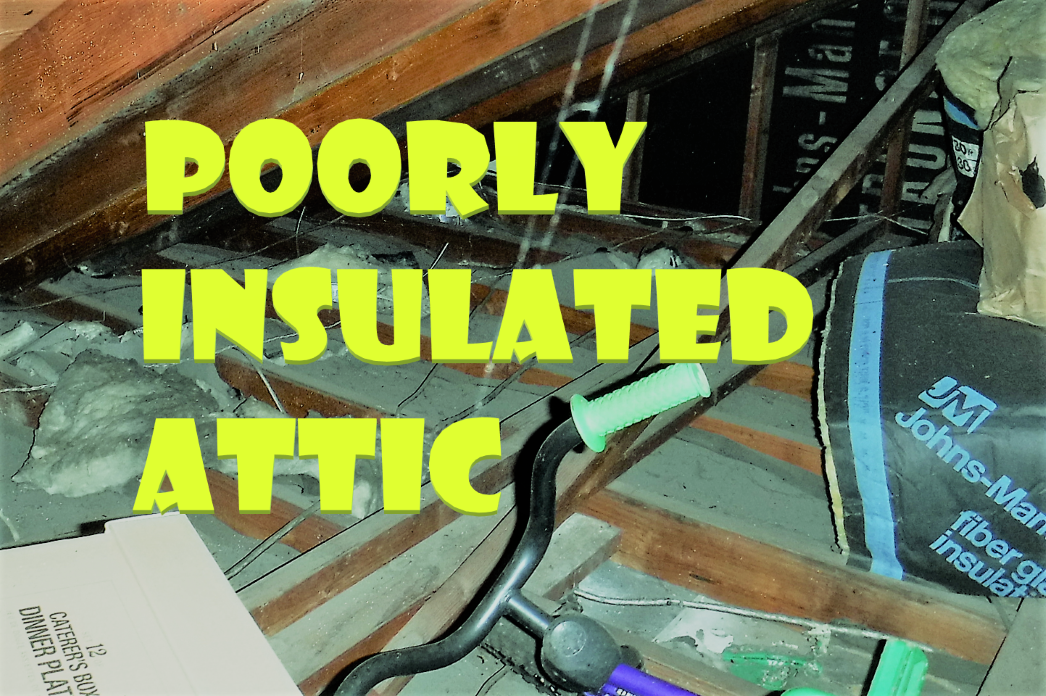
Hot Second Floors During Summer Are a Tell-Tale Sign that Your Insulation is Weak
Hot summers were another reason this homeowner was fed up and decided to take the next step. On hot humid Maryland summer days, it was nearly impossible to cool the bedrooms down.
If this is happening to you, it is a sign that your insulation is not working well for you.
Most insulation has one job - slow the transfer of heat. With the sun beating on your roof, radiant heat surges into the attic. When left unchecked - guess where it goes?
Directly into your house!
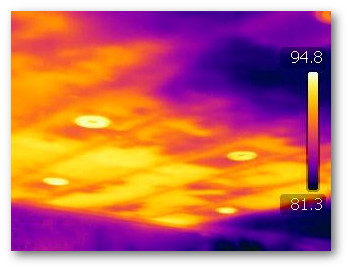
The right amount of insulation is needed to improve the boundary and optimize your ability to slow the movement of the heat.
During the winter, the insulation will help to contain your warm air inside your living bubble. During the summer months, it will work to keep the warm air out.
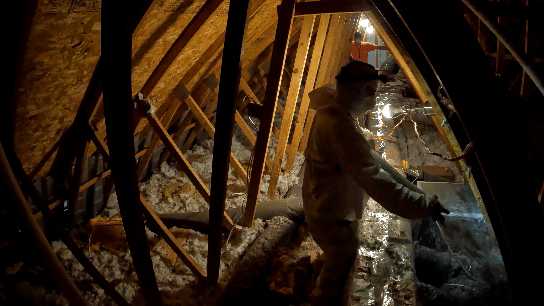
Identifying Insulation Problems in the Attic
Take a look at the attic inspection from the same Colonial style home energy audit.
See first-hand how it had many gaps to seal and insulation was missing leading directly to the comfort problems this family faced.
Learn about the following at various points in the video:
0:00 Start the Attic Assessment
0:40 Discolored Insulation Meaning
2:28 Uninsulated Pair of Skylights in Attic
3:09 Bathroom is Connected to the Attic
5:53 Closer Look at Bathroom Exhaust Fan
7:02 A Close Up Look at an Attic Baffle
9:03 How We Air Seal an Attic
9:21 See a Properly Insulated Skylight
9:47 Attic Hatch Treatment Process
10:50 Cantilever Blocking & Insulation Photos
Knee Wall Complexities
Colonial style homes that were built in the late 80's and beyond sometimes feature sloped ceilings and multiple skylights. These raised areas of the ceiling create walls in the attic that need to be properly insulated. Often times, they are not.

Gravity takes over with vertical attic knee walls and insulation is often times pulling away or completely falling.
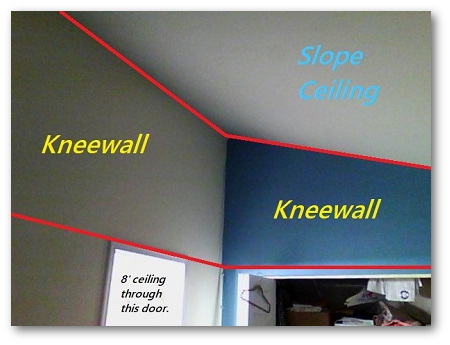
Knee walls are created when the bedroom or hallway ceiling raises up and an adjacent space has a traditional 8' flat ceiling.

When improperly insulated or as in some cases, not insulated at all, knee walls tend to lead to hot summers on upper floors of Colonial style houses.
Where Can You Begin When it Comes to Insulating Your Colonial Home?
A really great way to not get overwhelmed when it comes to improving insulation is to focus on the low hanging fruit.
When you seal and insulate in the right places, it can actually go a really long way towards better comfort and controlled energy bills.
Tightening up your Colonial style home is not an all or nothing type of approach, rather it can be methodical and targeted to yield the best results.
 I have over 2000 energy audits under my belt in Maryland. I enjoy teaching what I know to help guide homeowners towards better comfort & energy efficiency. It took me a while to figure things out. I can show you in a few hours.
I have over 2000 energy audits under my belt in Maryland. I enjoy teaching what I know to help guide homeowners towards better comfort & energy efficiency. It took me a while to figure things out. I can show you in a few hours.
The Future of Maryland Home Remodeling
The Inflation Reduction Act includes several incentivized programs to promote energy efficiency and combat climate change.
A big part of the bill gives rebates to homeowners who make the right energy-efficient upgrades to their homes.
Don't mistake this program for a rebate on windows and doors!
Even the President does not fully understand Home Performance, yet!
This is more of a Home Performance type of solution with Energy Audits and Whole House Solution Based Approaches that include impactful improvements like air sealing, insulation & duct sealing.
WATCH: Understanding how Maryland's current Home Performance with ENERGY STAR Program reports work will give you good insight.
Whole house solutions look to seal your house so your HVAC works less - saving you energy.
How Maryland Homeowners Will Benefit
This provision of the bill incorporated elements of legislation that Maryland lawmakers voted for called “HOPE for HOMES.”
U.S. Sen. Chris Van Hollen said there are “tremendous savings” in using energy more efficiently.
He pointed to the biggest hold up to a homeowner making improvements in their home to lower energy usage is the up-front cost.
Sometimes the up-front costs overshadow the savings gained over time and the 2022 bill makes getting the work done more attractive and affordable.
Under the Inflation Reduction Act, many homeowners will be eligible to recoup up to 50% of energy improvement costs — up to a maximum rebate of $4,000. Lower-income homeowners could be eligible for more generous rebates of up to 80% of costs, a maximum of $8,000.
INFLATION REDUCTION ACT SNAPSHOT SUMMARY: courtesy of Energy Circle
Rebates & Training Grants
Maryland residents can expect two major rebate program roll outs, better tax incentives and training dollars for local contractors to learn the key principles in order to keep up with demand.
2 MAJOR REBATE PROGRAMS FOR MARYLAND HOMEOWNERS
$4.3 Billion for HOMES (Home Owner Managing Energy Savings) Rebate Program
-
Rebates up to $4,000 for home energy efficiency retrofits with modeled energy savings of 35% or more (or $2,000 for 20-34% energy savings)
-
Services can include insulation, air sealing, heat pump/HVAC upgrades, and more
-
Additional rebates up to $8,000 available for low and moderate-income homeowners
-
Rebates cannot be combined with other federal grants or rebates
$4.5 Billion for High-Efficiency Electric Home Rebate Program
-
Rebates for low and moderate-income homeowners for electric system/appliance purchases and energy efficiency upgrades
-
Maximum rebate of $14,000; individual rebates are as follows:
-
Heat pump water heaters: $1,750
-
Heat pump HVAC systems: $8,000
-
Electric stoves: $840
-
Heat pump clothes dryers: $840
-
Electrical panel upgrades: $4,000
-
Insulation, air sealing, and ventilation: $1,600
-
Electric wiring: $2,500
-
-
Rebates cannot be combined with other federal grants or rebates
Tax Credits
More immediately, the new bill makes changes to tax credits for energy efficiency upgrades.
25C Tax Credit - Energy Efficiency Home Improvements (The Nonbusiness Energy Property Tax Credit)
-
Credit revived and made retroactive for 2022 (at original 10%). It went away and it is back!
-
Starting in 2023, the credit increases to 30% of total installation costs through 2032
-
The current lifetime cap of $500 will be replaced by cap of $600 per measure, with $1,200 annual total limit (exceptions listed below)
-
Eligible services and home improvements include:
-
Heat pumps and heat pump water heaters ($2,000 credit)
-
Insulation and air sealing
-
Energy audits ($150 credit)
-
Energy-efficient HVAC systems (including furnaces, boilers, and central AC)
-
Electrical panel upgrades
-
Energy-efficient windows and doors ($500 credit for doors)
-
Roofs are no longer eligible
-
FOR MARYLAND CONTRACTORS
The fact that there is a provision to train contractors is a strong indicator.
There is going to be a huge need for home improvement professionals to cross from other trades into home performance.
Just look at this report about the growing need for energy auditors and other professionals that will need to learn more about home performance - likely just to keep doing their own craft.
For example:
- Window people
- Siding people
- Roofing people
$200 Million for State-Based Home Energy Efficiency Contractor Training Grants
-
Training for contractors involved in installation of home energy efficiency and electrification improvements
-
Funding through September 2031
Conclusion
What is not clear as of yet is how these newly introduced funding and program parameters will fit into Maryland's current Home Performance with ENERGY STAR® Program which already offers incentives to Maryland homowners that make the right energy efficient upgrades to their attics, basements and crawl spaces.
Subscribe to my blog for updates and they piece things together.

Home performance work makes the difference in energy savings and better home comfort.
What is lurking in your attic?
Getting a home energy audit is one of those things that many do not fully comprehend the benefits until the assessment is complete. At that time, a well trained energy consultant will be able to walk you around your home and illuminate issues that you have likely been walking right past for many weeks, months or in some cases YEARS! Don't wait any longer and empower yourself TODAY to make your home more efficient, sustainable and comfortable.
At the completion of an energy audit I can feel the gratitude and appreciation flowing from my customers. I know that I have enlightened them on some level. Learning about some of the opportunities that houses with similar styles/build types will help you see the connection between the value of the energy audit and how it can help educate you and set you on the right path towards better comfort and energy efficiency...
Most are not familiar with the benefits of a comprehensive home energy audit. This article highlights the reasons it is beneficial and demonstrates why it should be an assessment everyone gets.
Sometimes the things we use, see and interact with everyday can be seen in a completely different light when someone teaches you something about it...





